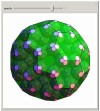 The Wolfram Demonstrations Project launched this week and represents what the developers describe as “a major new resource for research and education”. Well, that’s as maybe, but what is it? The project was first conceived by Stephen Wolfram creator of the Mathematica software that as its name suggests allows computers to produce visualisations of mathematical concepts.
The Wolfram Demonstrations Project launched this week and represents what the developers describe as “a major new resource for research and education”. Well, that’s as maybe, but what is it? The project was first conceived by Stephen Wolfram creator of the Mathematica software that as its name suggests allows computers to produce visualisations of mathematical concepts.
The project sits under the umbrella of open-code and uses dynamic computation to bring Mathematica’s prowess to bear on a range of endeavours in science, technology, mathematics, art, finance and more. You do not actually need Mathematica to try out the site, but interactivity comes into its own if you have the program on your system.
The Demonstrations site presents a good gallery of examples of what’s possible in Mathematica 6, although it is not yet complete in the sense that users and others can provide input and help it develop still further. “The Demonstrations are contributed by a mix of Wolfram employees and Mathematica enthusiasts,” site Manager Joe Bolte told us, “so some topics are better represented than others.” He adds that, “Now that the site development is largely complete, we should be able to use Mathematica’s strength’s to quickly help chemistry
catch up to our better represented topics.”
Which brings me to my first search. I did the obvious one for a chemist visiting the site and typed “molecules” into the search box. Just three demonstrations with that keyword came up – Insulin molecule, Lotus effect, cluster of 120 spheres. The insulin shows a mutant protein based on data from the Brookhaven Protein Data Bank and allows you to rotate the molecule in 3D, to hide and reveal various atoms, and to zoom in. Everything that chemists are used to doing with Chime or JMol.
Lotus is a little more gratifying. This demo places spheres on a larger sphere, copies this assembly and places the duplicates on a still larger sphere. It heads towards a fractal structure and so can mimic the surface morphology of lotus leaves, which have incredible self-cleaning and water repellent properties. You can see an artificial lotus leaf surface in action in our video section.
The Lotus demo allows you to vary the size and spacing of the virtual balls and so allows you to emulate molecular and atomic clusters and viruses. There are other specialist tools for doing such manipulations with more accurate models of such entities, but the demonstration does indeed produce some very or ornamental images.
The final demonstration that showed up in my search also simulates molecular structure in a novel way. In this producing 3D models that resemble the shape, but not quite, of the [60]fullerene molecule, better known as the buckyball. Although such a representation may not be accurate in terms of the chemistry, playing with these structures could inspire new ideas with regard to what might be possible experimentally in terms of geometry. After all, Kroto, Smalley and colleagues figured out the buckyball structure when they realized it might resemble a soccerball.
Searching for the word “chemistry” itself threw up quite a few more demonstrations related to the field, including generalized Arrhenius function, a buckyball of buckyballs, discrete reaction and diffusion, and one on carbon dating. All provide a unique view of various physical phenomena.
Mathematica is a powerful tool and the demonstrations provide a superb showcase of the kinds of graphics it can produce.
I asked Bolte more about the technical extension of the site. “Mathematica’s high-level language makes it easy to quickly display data and prototype algorithms in a way that no other software package can match,” he explains, “And new in version 6, it has built-in access to databases of relevant data that are available with a single line of code.”
The system is backed up with a range of data sources, including chemical data and element data sources. Closely related is the Periodic Table by co-founder and chemist Theodore Gray.